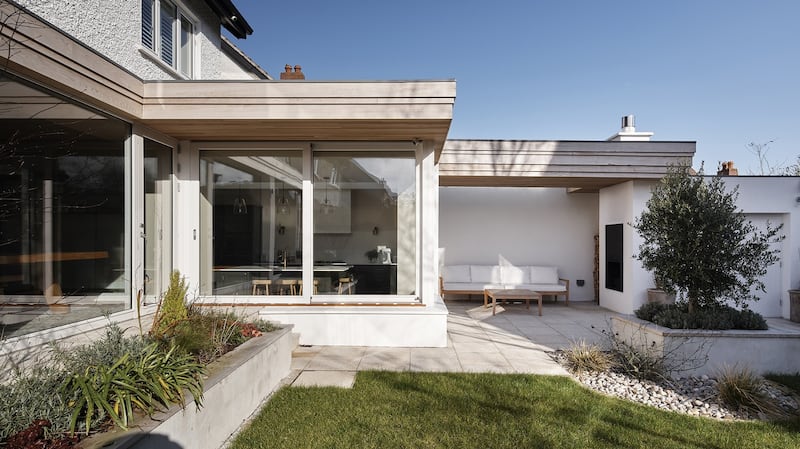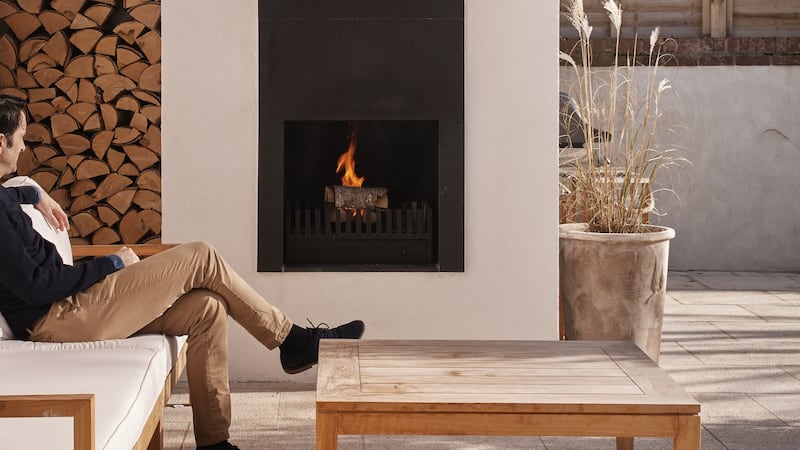It’s a truism that one of the things you can never change about your home is its aspect.
So how do you add a sunny south-facing extension to a dark-ish, east-facing rear? This was a challenge facing Mark Arigho of Arigho Larmour Wheeler Architects on a recent project in a typical suburban detached house in Cabinteely, south Dublin, originally built in 1995.
The kitchen extension was part of a full refurbishment and extension; the dining and kitchen spaces in the original house were small, and the back faces east. Behind the house, in the back garden, a very small garage was accessed by a narrow driveway along the side of the house. The brief was to reconfigure and extend to create more living space, connecting the garden with the ground floor, with a bigger kitchen, and linking the dining room to the sitting room to the west.
0 of 6
What they got was more space, and – kaboom – a sunny kitchen and sheltered outdoor living space to boot.
Instead of a large extension the entire width of the house, the architects opted for one that is essentially L-shaped, making the most of the aspect. Mark Arigho decided to knock the garage behind the house and extend into a south-facing kitchen there, incorporating part of the 2.2m wide driveway between the house and boundary wall. So the new kitchen runs along this boundary to the north, with a glass façade facing south.
Delineated spaces
Overall, the sitting, kitchen, dining rooms are open, without doors between them, but the design eschews a wide open-plan area – “they are difficult to live in, people don’t want big open spaces any more”, says Arigho. Instead, spaces are delineated without doors, using different ceiling and floor levels (the kitchen is three steps down from the dining area), screening and a dual aspect fireplace between the sitting and dining rooms.
Along the back “we got rid of the suburban openings”, and as steel was needed to hold up the back of the house, it cost little extra to extend by just 800m across the 7m width of the house, increasing the living and dining space and connecting them with the kitchen extension, which then juts out from this. The dining room is now a spacious central space, which you can see through steel-framed glass double doors when you enter the house, and beyond to light and planting in the raised bed close to the house, which separates the house from the back lawn.



Beyond the kitchen, continuing along the boundary, a new outdoor living area was created, which the owners have been enjoying since the middle of last summer, says Arigho. The area is well sheltered by the canopy, is bright because of a roof light, with an inset outdoor fireplace and basket; it’s a protected outdoor space, extending evenings outside in summer, or offering protection when leaving a window or door open when it’s mild but raining.
Timber fascia
Wrapping it all together, aesthetically and practically, is a timber fascia: it sits tight to the east-facing façade along the back of the house, then widens to form a canopy or overhang when it turns south to run along the kitchen (for shade and protection), and continues to form the roof of the outdoor living space, resting on the external fireplace.
The architects took inspiration from the steel fascia on Mies van der Rohe's Farnsworth House (1951) in Illinois, which provides a drip, creates shadow and makes up the structural depth behind. On this Dublin house, Arigho Larmour Wheeler used a deep cedar fascia structure (housing insulation, gutter and drainage), with detailing which breaks it up visually.
The fascia visually connects all three elements – the original back of the house, the kitchen extension and the new outdoor living space. The large glazing is timber-framed, painted white; the only variation from white walls and windows is the cedar fascia, offering a pleasing simplicity – “the planning, the design and the detailing work together”, says Arigho.
Timber specialists MTS in Kilcoole made the cedar fascia, which is treated with Sioox to protect it from sun and rot (it will need to be retreated in about 20 years), and ensuring even colour and ageing.
The south-facing kitchen, larger living and dining room, plus outdoor living space, were achieved within an overall extension of just 30sq m (despite the garage’s building precedent, planning permission was needed as the kitchen extends to the side). Plus, only 4sq metres of space was lost from the garden for the overall extension. Kaboom, indeed.


















